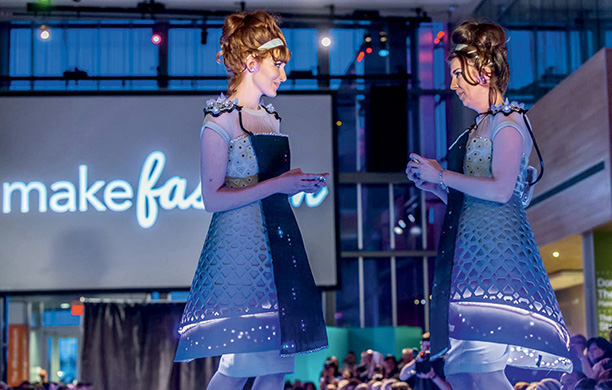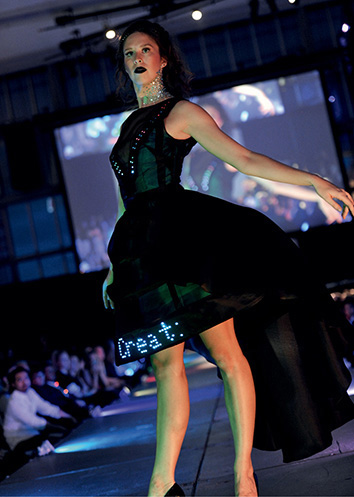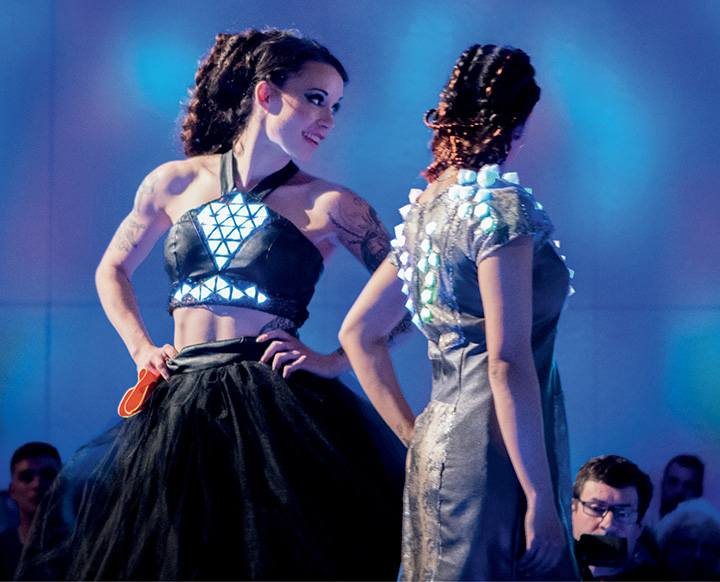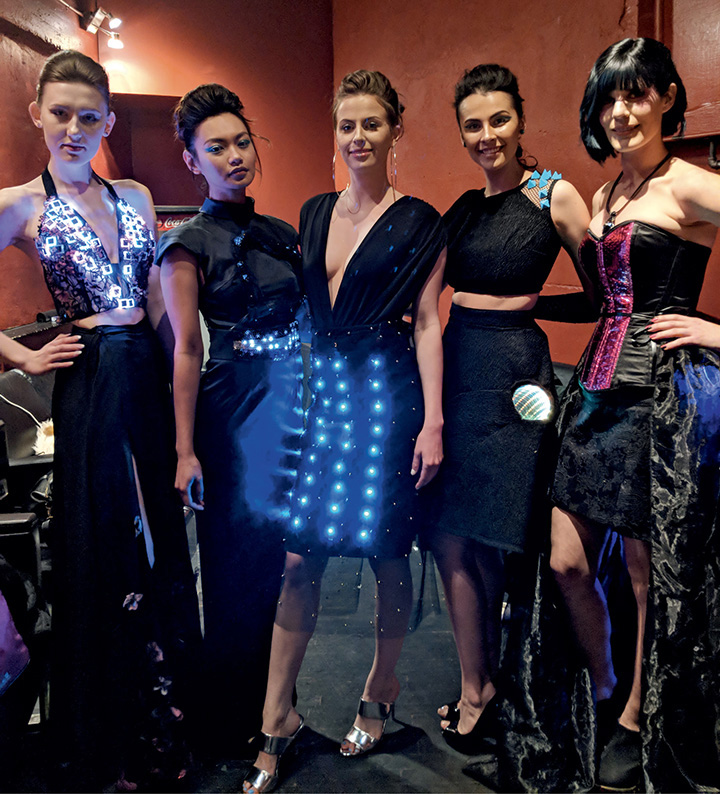CHAPTER 1
Introduction
WITH WEARABLE TECHNOLOGY, YOU CAN MAKE FUNCTIONAL, USEFUL, AND BEAUTIFUL GARMENTS that become an interface, connecting people to other people and promoting meaningful interactions between individuals and the whole of the world around them. Clothes become another part of the digital world, interacting with smartphone applications and social media views and giving onlookers a glimpse into your personality, your mood, and even your thoughts. In this book we’ve designed projects that combine electronics with modern fabrication technology such as 3D printers and laser cutters to produce wearable projects that a few years ago were only accessible to major designers and fashion houses. Using home machines and shared makerspaces, you can make personalized clothing and accessories that bring the imaginings of a science fiction future to today.
Electronics, whether a simple light-up circuit or a complex programmed design, can create visual interest and fun interactive clothing. Want to play video games directly on your clothes? The Gamer Girls dresses by Phi Designs uses programmable lights for two players to play against each other right on the front of the dresses (Figure 1.1).
Figure 1.1 Gamer Girl dresses by Phi Designs use microcontrollers and addressable light-emitting diodes (LEDs) to play a video game right on the wearer’s dress. (Courtesy of Ernesto Augustus at the Make Fashion Gala, 2016)
Other clothes can interact with social media, using smartphone applications and microprocessors to display words from Twitter or other social platforms. Reflections, designed by Amped Atelier, uses a smartphone app to scroll words on the front of an evening gown (Figure 1.2).
Figure 1.2 Connecting LEDs with a smartphone app allows clothes to display words, animations, and even social media connections. (Courtesy of Rafal Wegiel at the Make Fashion Gala, 2015)
Using the tutorials in this book, you will be able to make your own projects combining electronics and basic sewing to make clothes that glow and twinkle. Precision cutting and engraving using laser cutters creates intricate, detailed decoration and rapid fabrication of fashion-forward accessories.
The projects in this book will guide you through using laser-cut fabric as a design element, as well as using the laser to make a modern acrylic clutch purse. 3D printing makes tabletop production of components and tools easy and affordable. 3D printers can also be used to make fantastic decorations and light-up embellishments (Figure 1.3).
Figure 1.3 3D printing creates futuristic light diffusers and unique embellishments. (Courtesy of Jeff McDonald at the Make Fashion Gala, 2016)
In addition to using 3D printers to make electronics enclosures, these projects will use 3D printing to make accessories and produce personalized clothes (Figure 1.4).
Figure 1.4 Wearable technology makes functional and beautiful garments that can interact with the wearer and the environment. (Courtesy of Maria Elena Hoover at the Motion Ball, 2018)
The Projects
Maybe you’ve seen 3D printers and wondered how they can be useful for wearable projects. Or maybe you make your own clothes and want to add modern glitz and interaction. If you are a maker, programmer, costumer, cosplayer, hacker, engineer, or someone who wants to experiment and learn, this book is for you. The projects are designed to combine the advantages of rapid fabrication using 3D printers and laser cutters with basic sewing construction. Creating wearable electronics fashion requires using skills from sewing, programming, computer-aided design (CAD), and many more disciplines. This book will provide a basic introduction to wearable technology with the goal of completing the specific projects and inspiring creativity. There are many fantastic resources available from this publisher and others to help develop your skills in sewing and garment construction and to learn more about the intricacies of electronics and programming. For projects that require sewing an entire garment or accessory, we’ve provided no-sew or low-sew alternatives for incorporating the electronics and fabrication techniques onto purchased clothing and bags.
This book will take you step-by-step through making projects using the 3D printer and laser cutter and building electronics skills. Each project will use information from the introductory chapters and the preceding projects to guide you from constructing simple electronic circuits to using microcontrollers such as the Arduino while introducing major programming methods including visual block programming and the Arduino IDE.
Wherever possible, we’ve provided electronic downloads that are available from the book website with clothing and accessory patterns, CAD files for laser cutting, 3D printing files, and microcontroller programs to help you complete your projects. The projects use a variety of different materials, including knit fabric, polylactic acid (PLA) plastic, acrylic, and even fiber-optic fabric. When you understand how to make wearable projects, you can experiment with different materials and mix-and-match techniques, combining parts of projects together to make the perfect personalized clothes and accessories.



